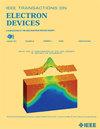A New Method for High Power Sheet Beam Traveling Wave Tube by Rotating the Beam Tunnel
IF 3.2
2区 工程技术
Q2 ENGINEERING, ELECTRICAL & ELECTRONIC
引用次数: 0
Abstract
The instability of the sheet electron beam (SEB) is an essential factor for limiting the power of the SEB traveling wave tube (TWT). To solve this issue, this article proposes a method to improve the output power of SEB TWTs, which introduces a rotating electron tunnel, following the SEB’s deflection instability, to significantly increase the input current and output power. In addition, the outer profile of the slow wave structure (SWS) is formed as a cylindrical to prevent this rotation from changing the high-frequency characteristics. To verify this method, a novel staggered double vane with a rotating tunnel (SDV-RT) SWS is proposed in this article. Moreover, a W-band TWT employing this new SWS is designed and simulated. The results illustrate that the beam current increases by approximately 57% under a uniform magnetic field of 0.85 T. Simulation results indicate that the designed SDV-RT TWT, operating with 1.1-A beam current and 27-kV beam voltage, achieves an output power over 2400 W, with a maximum power of 2759 W at 92 GHz. The output power is approximately 60% higher than that of conventional SDV devices under the same magnetic field. Additionally, an electron optical system (EOS) is designed to validate the effect of the RT method on enhancing output power under conditions of nonideal SEB and nonideal uniform magnetic fields. At last, the designed SWS has been fabricated, and the cold test results indicate that the S11 is below −16.5 dB and the S21 is above −2 dB in the frequency range of 90–100 GHz, showing good agreement with the simulation results.旋转波束隧道的大功率片束行波管新方法
薄片电子束的不稳定性是限制薄片电子束行波管功率的一个重要因素。针对这一问题,本文提出了一种提高SEB行波管输出功率的方法,即在SEB偏转不稳定的情况下,引入旋转电子隧道,显著提高输入电流和输出功率。此外,慢波结构(SWS)的外廓线形成圆柱形,以防止这种旋转改变高频特性。为了验证该方法,本文提出了一种新型的带旋转隧道的交错双叶片SWS (SDV-RT)。最后,设计并仿真了一个w波段行波管。结果表明,在0.85 t的均匀磁场下,波束电流增加了约57%。仿真结果表明,在所设计的SDV-RT行波管在1.1 a波束电流和27 kv波束电压下工作时,输出功率超过2400 W,在92 GHz时最大功率为2759 W。在相同磁场下,输出功率比传统SDV器件高约60%。此外,设计了一个电子光学系统(EOS),验证了RT方法在非理想SEB和非理想均匀磁场条件下提高输出功率的效果。最后对设计的SWS进行了制作,冷态测试结果表明,在90 ~ 100 GHz频率范围内,S11在−16.5 dB以下,S21在−2 dB以上,与仿真结果吻合较好。
本文章由计算机程序翻译,如有差异,请以英文原文为准。
求助全文
约1分钟内获得全文
求助全文
来源期刊

IEEE Transactions on Electron Devices
工程技术-工程:电子与电气
CiteScore
5.80
自引率
16.10%
发文量
937
审稿时长
3.8 months
期刊介绍:
IEEE Transactions on Electron Devices publishes original and significant contributions relating to the theory, modeling, design, performance and reliability of electron and ion integrated circuit devices and interconnects, involving insulators, metals, organic materials, micro-plasmas, semiconductors, quantum-effect structures, vacuum devices, and emerging materials with applications in bioelectronics, biomedical electronics, computation, communications, displays, microelectromechanics, imaging, micro-actuators, nanoelectronics, optoelectronics, photovoltaics, power ICs and micro-sensors. Tutorial and review papers on these subjects are also published and occasional special issues appear to present a collection of papers which treat particular areas in more depth and breadth.
 求助内容:
求助内容: 应助结果提醒方式:
应助结果提醒方式:


